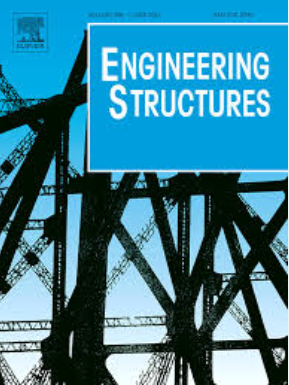A reconfigurable mechanical structure inspired by the mechanism of Rubik’s cube: Design, analysis and experiment
IF 6.4
1区 工程技术
Q1 ENGINEERING, CIVIL
引用次数: 0
Abstract
Reconfigurable mechanical structures refer to a class of systems whose geometric configurations, topological structures, or functional characteristics can be altered through systematic designs. The characteristics of Rubik’s Cube, which achieves an exponential number of topological configurations through rotational transformation rules and modular combinatorics, provide an idealized model for studying modular reconfigurable mechanical structures. This research proposes a design of a reconfigurable mechanical structure inspired by topological mechanisms of Rubik’s Cube (RC-RMS), integrated with mass-spring-damping units (MSDU), to investigate its multiple-dimensional dynamic characteristics for vibration suppression with a programmable algorithm, numerical analyses, and experimental validations. The dynamic analyses reveal that the developed RC-RMS enables resonant frequency tuning through rotation, and exhibits different dynamic response characteristics manipulated via the six degrees of freedom (6 DOF). Experimental validations via the single degree of freedom (single DOF) and two degrees of freedom (2 DOF) vibration platform are further constructed. The results of forced vibration experiments demonstrate that each configuration with the z-DOF of RC-RMS could achieve the vibration suppression of the amplitude in the single degree of freedom vibration platform by more than 64 %. This research provides a novel idea for designs of reconfigurable mechanical structures inspired by Rubik’s Cube, which are able to modify its dynamic features to satisfy dynamic demands in a complex excitation environment, achieve energy absorption with multiple frequencies and directions, and realize a wider range of functional combinations through modular combinations.
受魔方机制启发的可重构机械结构:设计、分析与实验
可重构机械结构是指可以通过系统设计改变其几何构型、拓扑结构或功能特征的一类系统。魔方通过旋转变换规则和模块化组合学实现指数级拓扑构型的特性,为研究模块化可重构力学结构提供了理想模型。本研究以魔方(RC-RMS)的拓扑机制为灵感,设计了一种可重构的机械结构,结合质量-弹簧-阻尼单元(MSDU),通过可编程算法、数值分析和实验验证,研究了其振动抑制的多维动态特性。动力学分析表明,所开发的RC-RMS可以通过旋转实现谐振频率调谐,并通过6自由度(6 DOF)操纵显示出不同的动态响应特性。搭建了单自由度(single DOF)和二自由度(2dof)振动平台进行实验验证。强制振动实验结果表明,采用RC-RMS的z-DOF的每一种构型都能实现对单自由度振动平台幅值的抑制幅度达64% %以上。本研究为受魔方启发的可重构机械结构的设计提供了一种新的思路,可以修改其动态特性以满足复杂激励环境下的动态需求,实现多频率、多方向的能量吸收,并通过模块化组合实现更大范围的功能组合。
本文章由计算机程序翻译,如有差异,请以英文原文为准。
求助全文
约1分钟内获得全文
求助全文
来源期刊

Engineering Structures
工程技术-工程:土木
CiteScore
10.20
自引率
14.50%
发文量
1385
审稿时长
67 days
期刊介绍:
Engineering Structures provides a forum for a broad blend of scientific and technical papers to reflect the evolving needs of the structural engineering and structural mechanics communities. Particularly welcome are contributions dealing with applications of structural engineering and mechanics principles in all areas of technology. The journal aspires to a broad and integrated coverage of the effects of dynamic loadings and of the modelling techniques whereby the structural response to these loadings may be computed.
The scope of Engineering Structures encompasses, but is not restricted to, the following areas: infrastructure engineering; earthquake engineering; structure-fluid-soil interaction; wind engineering; fire engineering; blast engineering; structural reliability/stability; life assessment/integrity; structural health monitoring; multi-hazard engineering; structural dynamics; optimization; expert systems; experimental modelling; performance-based design; multiscale analysis; value engineering.
Topics of interest include: tall buildings; innovative structures; environmentally responsive structures; bridges; stadiums; commercial and public buildings; transmission towers; television and telecommunication masts; foldable structures; cooling towers; plates and shells; suspension structures; protective structures; smart structures; nuclear reactors; dams; pressure vessels; pipelines; tunnels.
Engineering Structures also publishes review articles, short communications and discussions, book reviews, and a diary on international events related to any aspect of structural engineering.
 求助内容:
求助内容: 应助结果提醒方式:
应助结果提醒方式:


